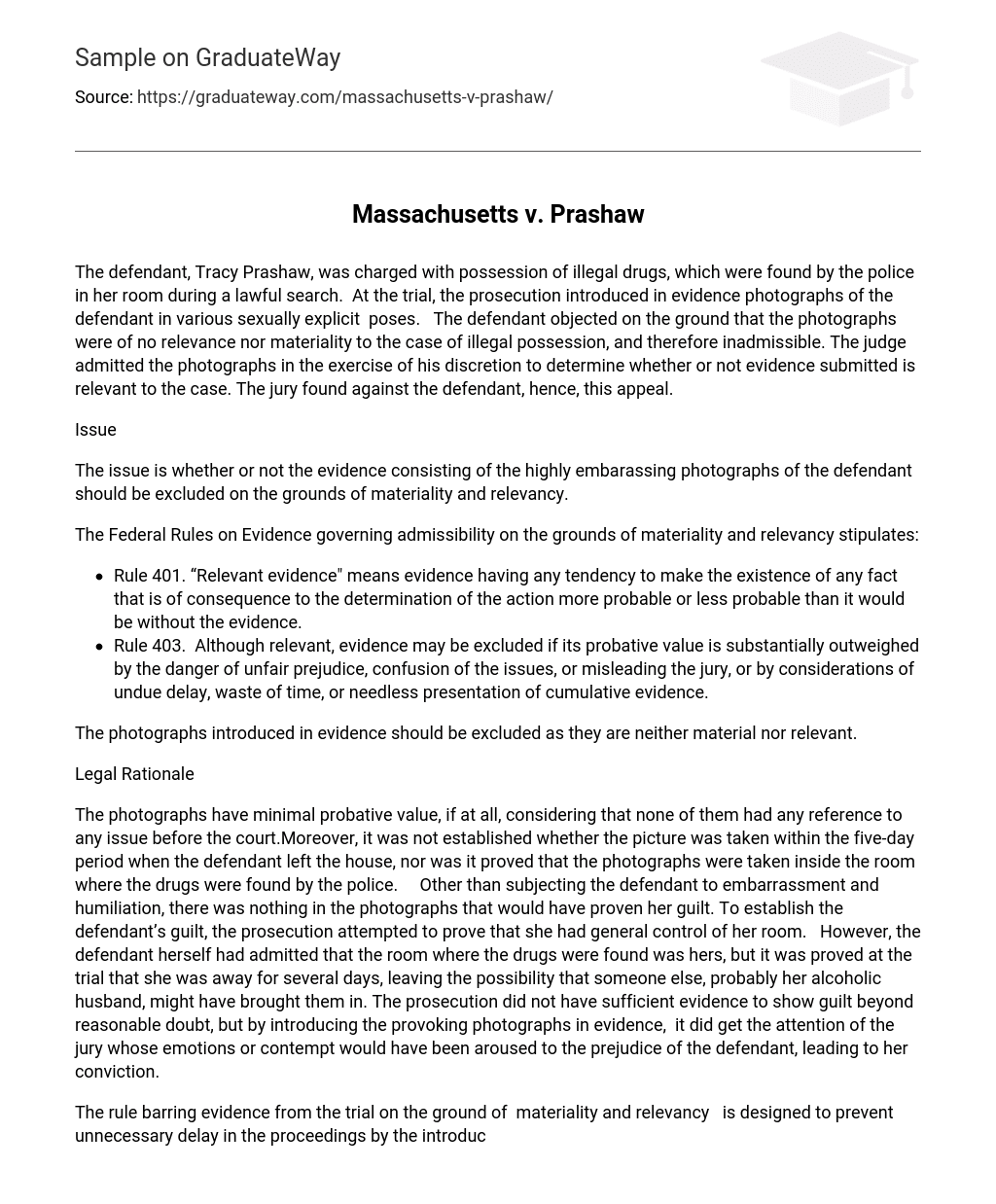The defendant, Tracy Prashaw, was charged with possession of illegal drugs, which were found by the police in her room during a lawful search. At the trial, the prosecution introduced in evidence photographs of the defendant in various sexually explicit poses. The defendant objected on the ground that the photographs were of no relevance nor materiality to the case of illegal possession, and therefore inadmissible. The judge admitted the photographs in the exercise of his discretion to determine whether or not evidence submitted is relevant to the case. The jury found against the defendant, hence, this appeal.
Issue
The issue is whether or not the evidence consisting of the highly embarassing photographs of the defendant should be excluded on the grounds of materiality and relevancy.
The Federal Rules on Evidence governing admissibility on the grounds of materiality and relevancy stipulates:
- Rule 401. “Relevant evidence” means evidence having any tendency to make the existence of any fact that is of consequence to the determination of the action more probable or less probable than it would be without the evidence.
- Rule 403. Although relevant, evidence may be excluded if its probative value is substantially outweighed by the danger of unfair prejudice, confusion of the issues, or misleading the jury, or by considerations of undue delay, waste of time, or needless presentation of cumulative evidence.
The photographs introduced in evidence should be excluded as they are neither material nor relevant.
Legal Rationale
The photographs have minimal probative value, if at all, considering that none of them had any reference to any issue before the court.Moreover, it was not established whether the picture was taken within the five-day period when the defendant left the house, nor was it proved that the photographs were taken inside the room where the drugs were found by the police. Other than subjecting the defendant to embarrassment and humiliation, there was nothing in the photographs that would have proven her guilt. To establish the defendant’s guilt, the prosecution attempted to prove that she had general control of her room. However, the defendant herself had admitted that the room where the drugs were found was hers, but it was proved at the trial that she was away for several days, leaving the possibility that someone else, probably her alcoholic husband, might have brought them in. The prosecution did not have sufficient evidence to show guilt beyond reasonable doubt, but by introducing the provoking photographs in evidence, it did get the attention of the jury whose emotions or contempt would have been aroused to the prejudice of the defendant, leading to her conviction.
The rule barring evidence from the trial on the ground of materiality and relevancy is designed to prevent unnecessary delay in the proceedings by the introduction of evidence with little or no probative value. Worse, it might create an unfavorable impression or prejudice on the jury against the defendant although such evidence has nothing with to do with the crime charged.
The determination of whether evidence is relevant or not is left to the discretion of the trial judge, but it should be exercised with due caution. When the judge admitted the photographs against the objection of the defendant, he committed a reversible error. Accordingly, the judgment of conviction was reversed and the case remanded for trial.
The rules on materiality and relevancy, although procedural, are in pursuance of the constitutional mandate that guarantees the right to due process of every citizen. By inquiring into the materiality or relevance of evidence submitted on trial, the courts will see to it that that right is protected and upheld.
The following questions are addressed in this case: Why is there a need to determine relevance or materiality when presenting evidence at the trial? Is the discretion of the judge as to admissibility of evidence absolute? Why are evidences such as the photographs in question not admissible?
The ruling laid down in this case are of interest to lawyers, law-enforcers, criminologists, forensic personnel, law students, judges, and guardians of civil rights.
Works Cited
- Institute, Legal Information. Federal Rules of Evidence. Available at: http://www. Lii.law.cornell.edu/rules/fre/rules.htm. Accessed 20 August 2005.
- Massachusetts, Appeals Court. Massachusetts v. Prashaw, Massachusetts. 2003.





